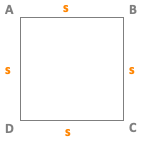Perimeter of a square |

|
|
|
|
A side of the square = s AB = BC = CD = DA ExampleABCD is a square with side s = 5 cmPerimeter A of the square ABCD = 4s = 4 x 5 = 20 cm Calculate the perimeter of a square |
Definition of a squareA square is a plane figure with four equal sides and four right (90°) angles.A square is a quadrilateral that has 4 sides of the same length and 4 right angles. To calculate the perimeter of a square, multiply one of its sides by 4. The length of all the four sides of a square are equal, so the perimeter is four times the length of any side of a square. The perimeter of a square is the total length of the four equal sides of the square. Properties of a squareA square has its diagonals of the same length, which intersect in their middle and are perpendicular.A square has its opposite sides two by two parallel. The diagonals of a square bisect each other at 90°. The length of the diagonals of a square is equal. The sum of all interior angles of a square is 360°. All four sides of the square are equal to each other. The opposite sides of a square are parallel to each other. To go furtherA square is a quadrilateral, as it has 4 sides and 4 angles.A square is a rectangle. Indeed it has 4 right angles. A square is a rhombus. Indeed it has its 4 equal sides. Since the sides of a square are parallel, a square is a parallelogram. The perimeter of a square is the total length of all the sides of the square. Indeed we can find the perimeter of a square by adding all its four sides. The perimeter is the length of the outline of a shape. Multiply the side length of the square by four to find the perimeter. The perimeter of a square is the sum of the length of all four sides. |